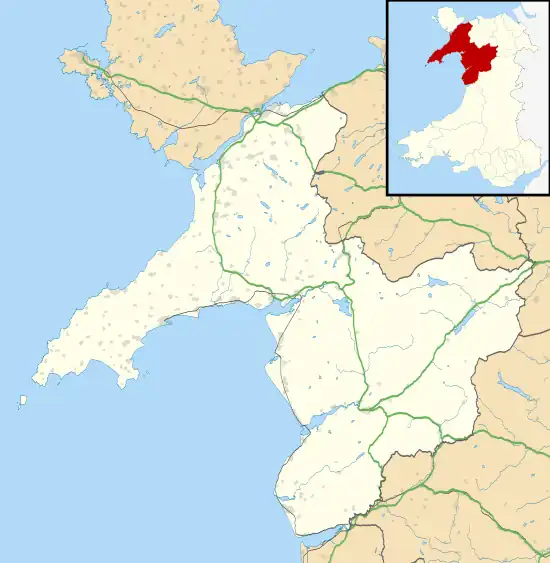Llanuwchllyn
Llanuwchllyn (Welsh: [ɬaˈnɨuχɬɨn] ⓘ) is a village and community in Gwynedd, Wales, near the southern end of Bala Lake (Llyn Tegid). It is one of the most sparsely populated communities in Wales.
| Llanuwchllyn | |
|---|---|
 Main street in 2007 | |
 Llanuwchllyn Location within Gwynedd | |
| Area | 116.93 km2 (45.15 sq mi) |
| Population | 617 (2011) |
| • Density | 5/km2 (13/sq mi) |
| OS grid reference | SH877299 |
| Community |
|
| Principal area | |
| Country | Wales |
| Sovereign state | United Kingdom |
| Post town | BALA |
| Postcode district | LL23 |
| Dialling code | 01678 |
| Police | North Wales |
| Fire | North Wales |
| Ambulance | Welsh |
| UK Parliament | |
| Senedd Cymru – Welsh Parliament | |


The electoral ward includes the small settlement of Llangywer.
The parish church of St Deiniol is a Grade II* listed building.[1]
Llanuwchllyn railway station is the headquarters of the narrow gauge Bala Lake Railway, centred on the former Great Western Railway station on the standard-gauge line from Ruabon to Barmouth.
The village was the birthplace of Welsh language author and educationalist Owen Morgan Edwards.
Caer Gai, a Roman fort near Llanuwchllyn, was traditionally known as the home of Cei, the character in the Arthurian legend known in English as Sir Kay. Poets of the 15th century recorded a story, ultimately deriving from the Prose Merlin included in the Lancelot-Grail and the Post-Vulgate Cycle, that King Arthur and Cei were brought up at Caer Gai as foster brothers.[2] Caer Gai is also Grade II* listed.[3]
Demographics
Welsh language
According to the 2011 Census, Llanuwchllyn is the community with the 2nd highest percentage of Welsh speakers in Wales. 83.5% of residents aged three and over reported being able to speak Welsh in the 2011 Census, as compared to 84.7% reporting being able to do so in the 2001 Census.[4] The figure rose slightly to 83.9% by the 2021 Census. [5]
Ethnicity
As of the 2021 Census, the Llanuwchllyn electoral ward was the least ethnically diverse ward in England and Wales. 99.2% of residents were White British, 0.2% were White Irish, 0.3% were White Other, and 0.3% were mixed race.[6]
Governance
An electoral ward with same name exists. This ward also includes the community of Llangywer with a total population taken at the 2011 census of 877.[7]
Notable people
- John Richards (1765–1850), schoolmaster, became an American politician in New York.
- Michael D. Jones (1822–1898) a Welsh Congregationalist minister, principal of a theological college and co-founder of the Welsh settlement of Y Wladfa in Patagonia.
- Sir Owen Morgan Edwards (1858–1920) historian, educationalist and writer.
- John Meirion Morris (1936–2020), sculptor.[8]
Notes
- "Parish Church of St Deiniol, Llanuwchllyn". British Listed Buildings. Retrieved 17 December 2013.
- Bromwich, p. 311.
- "Caer Gai, including adjoining forecourt walls to the NE, Llanuwchllyn". British Listed Buildings. Retrieved 17 December 2013.
- "Comisiynydd y Gymraeg - 2011 Census results by Community". www.comisiynyddygymraeg.cymru. Retrieved 4 September 2020.
- "Welsh language skills (speaking) - Office for National Statistics". www.ons.gov.uk. Retrieved 11 March 2023.
- "Ethnic group - Office for National Statistics". www.ons.gov.uk. Retrieved 11 March 2023.
- "Ward population 2011". Retrieved 17 May 2015.
- "Tryweryn monument sculptor John Meirion Morris dies age 84". Nation Cymru. 21 September 2020.
References
- Bromwich, Rachel (2006). Trioedd Ynys Prydein: The Triads of the Island of Britain. University Of Wales Press. ISBN 0-7083-1386-8.
